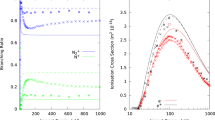Summary
Using our complete momentum measurements for 2-, 3-, 4-and 5-pion final states, we have studied the impact parameter structure with the following principal results: 1) evidence is presented for an empirical method that can help in the separation of coherent events on nuclei; 2) incoherent nuclear production exhibits lower-bound impact parameters which systematically decrease with increasing number of produced pions; 3) the experimentalb-distributions can be very well fitted by a single simple scaled functional form dσ N (b)/d2 b ∞F(N/f(b)); thisN-distribution yields a dispersion divided by an average, at any impact parameterb, of about 0.35.
Riassunto
Usando le nostre misure complete d’impulso per gli stati finali di 2, 3, 4 e 5 pioni si è studiata la struttura del parametro d’impatto con i seguenti risultati principali: 1) si presentano prove per un metodo empirico che può aiutare nella separazione di eventi coerenti sui nuclei; 2) la produzione nucleare incoerente mette in evidenza parametri d’impatto con limiti minori, che diminuiscono sistematicamente con l’aumentare del numero di pioni prodotti; 3) le distribuzionib sperimentali possono essere molto bene approssimate mediante una singola forma semplice funzionale variante di scala dσ N (b)/d2 b∞F(N/f(b)), la cui distribuzioneN dà una dispersione, divisa per la media, a qualsiasi parametro d’impattob, di circa 0.35.
Реэюме
Испольэуя иэмерения полного импульса 2-, 3-, 4- и 5-пионных конечных состояний, исследуется эависимость от прицельного параметра. Получены следуюшие основные реэультаты: 1) Предлагается подтверждение для змпирического метода, который может помочь при выделении когерентных событий на ядрах. 2) Некогерентное ядерное рождение обнаруживает нижнюю границу по прицельным параметрам, которые систематически уменьщаются при увеличении числа обраэованных пионов. 3) Экспериментальные 6-распределения можно хорощо подогнать с помошью единственного простого функционального выражения dσ N (b)/d2 b∞ ∞F(N/f(b)),N-распределение которого дает дисперсию, деленную на серднее эначение, для любого прицельного параметраb, приблиэительно 0.35.
Similar content being viewed by others
Literatur
B. R. Webber:Phys. Lett.,49 B, 474 (1974).
P. Bosetti, R. Honecker, P. Sixel, J. Kaltwasser, P. Kostka, M. J. Counihan, G. Kellner, D. J. Kocher, D. R. O. Morrison, K. Dziunikowska, T. Hirose, E. Leitner, T. C. Bacon, K. W. J. Barnham, P. J. Dornan, U. Magon, P. Williams, D. P. Dallman, P. Girtler, S. Sosnowski andA. Zieminski:Nucl. Phys.,97 B, 29 (1975).
S. Barshay:Phys. Lett.,42 B, 457 (1972).
S. Barshay andY. Yamaguchi:Phys. Lett.,51 B, 376 (1974).
R. Arnold, B. Escoubes, N. Kurtz, A. Lloret, M. Paty, J. L. Riester, S. De Unamuno, T. Gemesy, U. Janossy, S. Krasznovzsky, G. Pinter, N. Posch andF. Telbisz:Phys. Lett.,36 B, 261 (1971).
R. Arnold, J. P. Engel, B. Escoubes, N. Kurtz, A. Lloret, M. Paty, J. L. Riester, S. De Unamuno, T. Gemesy, U. Janossy, S. Krasznovzsky, G. Pinter, N. Posch andF. Telbisz:Nuovo Cimento,17 A, 393 (1973).
The effective value ofA is calculated fromA=(c 1 σ 1 A 1+c 2 σ 2 A 2+c 3 σ 3 A 3)/(c 1 σ 1+c 2 σ 2+c 3 σ 3), wherec 1,c 2,c 3 andA 1,A 2,A 3 represent the percentages in our target material and the atomic numbers of carbon, fluorine and bromine, respectively. The cross-sections for coherent production of three pions (σ 1,σ 2,σ 3) on targets (A 1,A 2,A 3) at 11.7 GeV/c have been interpolated from the results ofP. Mühlemann, K. Freundenreich, F. X. Gentit, G. Bellini, M. Di Corato, G. Vegni, C. Bemporad, W. Beusch, E. Polgar, D. Websdale, P. Astbury, J. G. Lee andM. Letheren:Nucl, Phys.,59 B, 106 (1973).
M. Haguenauer, W. Michael, P. Mine, U. Nguyen-Khac, A. Haatuft, A. Halsteinslid, M. Myklebost, K. Nordbø, J. M. Olsen, H. Annoni, R. Arnold, A. Lloret, M. Paty, J. L. Riester, B. Escoubes, L. Ferrer, P. Ladron De Guevara, R. Llosa andS. De Unamuno:Phys. Lett.,34 B, 219 (1971).
A. Haatuft, A. Haldenstein, K. Myklebost, K. Nordbø, J. M. Olsen, R. Arnold, B. Escoubes, A. Lloret, M. Paty, J. L. Riester, S. De Unamuno, M. Haguenauer, W. Michael, P. Mine, U. Nguyen-Khac, L. Ferrer, P. Ladron De Guevara, R. Llosa andM. Tomas:Nucl. Phys.,48 B, 78 (1972).
R. Blind, J. P. Engel, B. Escoubes, J. L. Guyonnet, M. Paty andJ. L. Riester:Nucl. Phys.,76 B, 61 (1974).
P. Mühlemann, K. Freundenreich, F. X. Gentit, G. Bellini, M. Di Corato, G. Vegni, C. Bemporad, W. Beusch, E. Polgar, D. Websdale, P. Astbury, J. G. Lee andM. Letheren:Nucl. Phys.,59 B, 106 (1973).
This effect is also seen experimentally, when going from Be to Pb, in the shift toward lower masses of the spectrum of coherently produced three-pion systems. See fig. 3 of ref. (11).
We hereafter refer to this as the peripherality variable and denote it simply byb. Similarly to the lower bounds, it may be a factor of about three below the « real » impact parameter. See ref. (2) and footnote (16) below.
L. Caneschi, P. Grassberger, H. I. Miettinen andF. Henyey:Phys. Lett.,56 B, 359 (1975).
J. L. Riester, R. Arnold, J. P. Engel andM. Paty:Nucl. Phys.,96 B, 407 (1975).
Perhaps the lower bounds are, on the average, a factor of about three below the « real » r.m.s. impact parameters (see ref. (2)), as, probably, the bounds in eqs. (2), (3) are.
Particle Data Group: LBL-53 (1973) (unpublished).
S. Barshay, A. Fridman andP. Juillot: CRN/HE 75-15 (unpublished).
J. B. Rushbrooke, R. A. Ansorge, C. P. Bust, J. R. Carter, W. W. Neale, C. Moore, R. Raja, L. Voyvodic, R. J. Walker, W. Morris, B. Y. Oh, D. L. Parker, G. A. Smith andJ. Whitmore:Phys. Lett.,59 B, 303 (1975).
Fermilab Single Arm Spectrometer Group:Phys. Rev. Lett.,35, 1195 (1975).
Author information
Authors and Affiliations
Additional information
To speed up publication, the authors of this paper have agreed to not receive the proofs for correction.
We have had valuable discussions with M. PATY.
Rights and permissions
About this article
Cite this article
Arnold, R., Barshay, S. & Riester, J.L. Impact parameter analysis of coherent and incoherent pion productions on nuclei by 11.7 GeV/c π+ . Nuov Cim A 35, 58–68 (1976). https://doi.org/10.1007/BF02730060
Received:
Published:
Issue Date:
DOI: https://doi.org/10.1007/BF02730060




